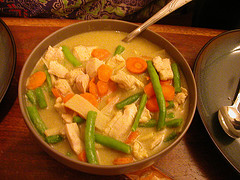by Vani Viswanathan
[box]Vani Viswanathan tells you about food she’s had in her trips around Southeast Asia, the interesting happenings around getting the food each time, and finally, what they made her realise. [/box]As a South Indian from a traditional family, trips I’ve taken as a kid easily fall under the following categories: pilgrimages with endless visits to temples, visits to other cities/towns where our relatives lived (including – of course – visits to temples), and finally, visits to popular destinations up north in the country where we’d invariably run into another family from the South that would have come to experience the unknowns of the North.
As a student in Singapore, my trips were quite limited, but things changed once I started working. Shortly after, I entered into the traveling frenzy prevalent in Singapore, with gusto, packing all long weekends with trips to some nearby destinations. God bless Singapore for its amazing location (and not to forget the budget airlines) – being just about two hours from nearly every popular tourist hotspot by flight, it’s ridiculously easy to plan a quick getaway.
In all the trips that I have made – ever since I was a toddler and carried around by my mother, I’m sure – food has played an extremely role. I remember times during our trips to the North when after endless meals of chapattis and dal, we’d feverishly hunt for a South-Indian restaurant to give some life to our tongues with our sambhars and chutneys. We’d dig into idlis like savages who’d not eaten for days, and my parents would be thanking their stars for that not-so-good-but-we-had-no-choice coffee served in the duvrah(stainless steel saucer)-tumbler. I also remember those trips to those small towns in Tamil Nadu where we’d enjoy the simple meals served in banana leaves by (most likely) an old man with his dhoti tied half-way up his legs.
This took a different turn when I started traveling from Singapore, for in Southeast Asia, forget bothering about the taste of the food, it’s quite difficult to get food if you happen to be a vegetarian. In nearly all of my trips around the place, my first meal would be the easy-to-order (‘no meat, no seafood, no fish, no shrimp paste, no egg’) fried rice. If I were lucky, the chef would be understanding and add a dash of vegetables like carrots, beans and such. If I were only slightly lucky, I’d only have some leaves in my fried rice. If I were truly unlucky, my fried rice would be plain and worse, brown, with all the frying.
However, experience has definitely made me wiser over the years; these days I am better prepared, packing biscuits, ready-to-eats, noodles and bread, depending on the city I’m going to.
The best trip to date after I came to Singapore– in terms of food – has been the one I took last year to Thailand. Don’t let the ever-smiling Thais fool you into thinking that their food will be any sweet – if you’re trying Thai food for the first time, you’ll be amazed by the twists and turns the food can take, spicy one minute, tangy another, sweet the next. With a generous dose of coconut, lotus roots and lemon grass, Thai food, according to me, is beaten only by Indian food in terms of spice. In Bangkok and Chiang Mai, I had absolutely no problems in getting the restaurateurs to understand requests for vegetarian food – better still, most had vegetarian options in their menus. For three whole days, I feasted on vegetarian Thai green curry, Phad Thai, Tom Yum, and other such mouthwatering Thai varieties. I would never forget our dinner in Chiang Mai – the setting was amazing, five-star like – we felt absolutely pampered – food was simply delicious, and the bill, yes, was incredibly low!
I wasn’t as lucky in Indonesia, though. We ate at restaurants famed for their aesthetic splendor – one, for example, was set right in the middle of the forest, atop a hill with a splendid view of the town below, and we sat in a little hut where we had to ring a wooden bell to call the waiter, and another, was another rustic little hut with wooden flooring that was damp from the rain – but the food tasted bland, and had an unbearably high dose of coconut. Indonesians, much like our Thai friends, smile a lot, and grin when they can’t understand something, that you just forget to be annoyed with them for not understanding ‘pegatarian’ (vegetarian in Bahasa Indonesia). For two days (after my first meal which was – guess what – fried rice!), I pushed in these bland dishes, not knowing what on earth they contained, nearly choking on them, until the last day when we found a huge mall in Jakarta with a food court, and I sighed with relief to find a Chinese stall that could make for me some vegetarian hor fun (noodles). Our last meal in Indonesia was from Pizza Hut.
Vietnam was a wholly different ball game. I starved the first morning – I had cake for breakfast in the famed Trung Nguyen coffee shops in Vietnam where filter coffee is popular but no good compared to the South Indian variety, at least in terms of the aroma. For lunch, I rushed to an Indian restaurant, had chole that was tasteless, and a few hours later attended a wedding dinner later that evening where one of the starters labeled vegetarian contained fish (needless to say, I looked a skeptically at everything else that was served thereafter). I’d planned to go to bed early hoping I’d fall asleep before I felt hungry, but no – I was soon starving, and without any other recourse, had to call room service who brought to me two loaves of toasted bread with a pinch of marmalade and butter, for which I had to pay USD 2 (which is a big deal in Vietnam!). The next morning, I got the receptionist to write out ‘vegetarian’ in Vietnamese for me, and went around showing the chit to ask for vegetarian food in every restaurant we went to, and that did help.
The Vietnamese are very pleasant people, always smiling, calm, quiet – and painfully shy! I remember I asked for chilli sauce at one of the restaurants and I was sure the waiter didn’t understand me, and I had an inkling then that I would never see the sauce – turned out I didn’t see the guy either; he avoided our table with as much tact as he could muster because he simply couldn’t understand what I wanted. At the end of the meal, I was so amused with the Vietnamese!
Malaysia has been relatively easy because its makeup is in many ways similar to Singapore’s – with Chinese, Malays and Indians. Worst case, you could simply find an Indian restaurant and speak in Tamil and get them to give you saiva saapadu (vegetarian food). Indian food in Malaysia has a strong influence from Malaysian food, so if you’re an Indian in Malaysia, you’ll be surprised by how different curries taste and how differently they prepare the simplest beans or potatoes. And you’ll perhaps come across Prata (parathas, in India!), Murtabak (apparently originated in India during the 16th century, but I had never come across it in India!), Roti John (a different kind of sandwich, let’s say) and Nasi Biryani (fragrant rice where you can choose what curry you want). Having lived in Singapore for a good number of years now, I’m hardly surprised at these strange dishes being called Indian, but it’s amazing how beautifully food evolves and blends into a place!
I love my trips around this region precisely for this – there’s a mind-blowing variety of food, and with each place, you get to see a bit of how people are as you eat in their restaurants, have them answer your incessant questions about what’s in this and in that, and watch them look at you with incredulity as you explain ‘no meat, no seafood, no egg, no shrimp paste’ (‘What does she eat,’ they wonder, I know), and dutifully go in to report whatever they understood of that. These trips have made me realise how often I’ve taken good food for granted while I was in India; I’ve never been a foodie, but after traveling around this region, I’ve come to really enjoy even a decent meal.
Pic by zappowbang: http://www.flickr.com/photos/zappowbang/






